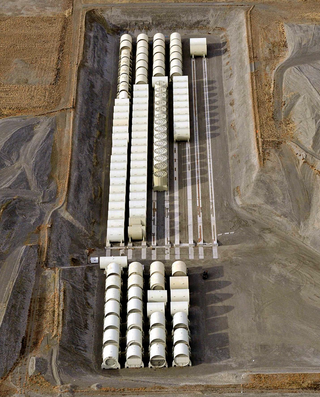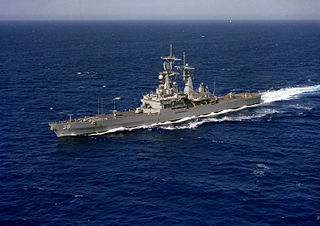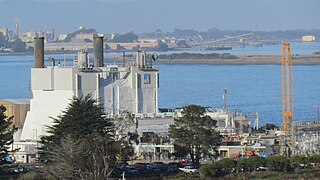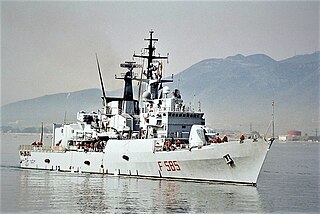Decommissioning is a general term for a formal process to remove something from an active status, and may refer to:
Decommissioning is a general term for a formal process to remove something from an active status, and may refer to:

Ship commissioning is the act or ceremony of placing a ship in active service and may be regarded as a particular application of the general concepts and practices of project commissioning. The term is most commonly applied to placing a warship in active duty with its country's military forces. The ceremonies involved are often rooted in centuries-old naval tradition.

The Trafalgar class is a class of nuclear-powered fleet submarines (SSNs) in service with the Royal Navy, and the successor to the Swiftsure class. Like the majority of Royal Navy nuclear submarines, all seven boats were constructed at Barrow-in-Furness shipyard, Cumbria. With only one boat remaining active and in commission and six retired from the seven originally in service, the class makes up part of the Royal Navy's nuclear-powered ‘hunter-killer’ submarine force. The Trafalgar class has nearly been replaced by the larger and more capable Astute class, of which five are commissioned.
Four vessels of the United States Navy have been named USS Louisville, after the city of Louisville, Kentucky:
Payoff may refer to:

The commissioning pennant is a pennant flown from the masthead of a warship. The history of flying a commissioning pennant dates back to the days of chivalry with their trail pendants being flown from the mastheads of ships they commanded. Today, the commissioning pennants are hoisted on the day of commissioning and not struck until they are decommissioned. Some navies have a custom of flying a "paying off" or "decommissioning pennant," the length of which often reflects the length of service of the warship.

The Virginia class were four nuclear-powered, guided-missile cruisers that served in the United States Navy until the mid-to-late 1990s. The double-ended cruisers were commissioned between 1976 and 1980. They were the final class of nuclear-powered cruisers completed and the last ships ordered as Destroyer Leaders under the pre-1975 classification system.

Dounreay is a small settlement and the site of two large nuclear establishments on the north coast of Caithness in the Highland area of Scotland. It is on the A836 road nine miles west of Thurso.

Garcia-class frigates were United States Navy warships. These frigates were originally ocean escorts bearing the hull classification DE until 1975. The ships were commissioned between 1964 and 1968 and decommissioned between 1988 and 1990.

USS Hyman G. Rickover (SSN-709), a Los Angeles-class submarine, was the first ship of the United States Navy to be named for Admiral Hyman G. Rickover, pioneer of the nuclear Navy, and the only Los Angeles-class submarine not named after a United States city or town. She was initially to be named USS Providence; however, following the retirement of Admiral Rickover, her name was reassigned prior to official christening. SSN-719 was later given the name USS Providence.

USS Buffalo (SSN-715) was a Los Angeles-class submarine, the second vessel that actively served the United States Navy to be named for Buffalo, New York. The contract to build her was awarded to Newport News Shipbuilding and Dry Dock Company in Newport News, Virginia on 23 February 1976, and her keel was laid down on 25 January 1980. She was launched on 8 May 1982 sponsored by Mrs. Joanne Kemp, wife of former Buffalo Bills quarterback and New York's 31st congressional district representative Jack Kemp, who was credited with winning approval to name the ship after the city in his district. Buffalo was commissioned on 5 November 1983, with Commander G. Michael Hewitt in command. Buffalo was decommissioned on 30 January 2019 after 35 years of service.

The Shippingport Atomic Power Station was the world's first full-scale atomic electric power plant devoted exclusively to peacetime uses. It was located near the present-day Beaver Valley Nuclear Generating Station on the Ohio River in Beaver County, Pennsylvania, United States, about 25 miles (40 km) from Pittsburgh.

Nuclear decommissioning is the process leading to the irreversible complete or partial closure of a nuclear facility, usually a nuclear reactor, with the ultimate aim at termination of the operating licence. The process usually runs according to a decommissioning plan, including the whole or partial dismantling and decontamination of the facility, ideally resulting in restoration of the environment up to greenfield status. The decommissioning plan is fulfilled when the approved end state of the facility has been reached.

The Humboldt Bay Power Plant, Unit 3 was a 63 MWe nuclear boiling water reactor, owned by Pacific Gas and Electric Company that operated from August 1963 to July 1976 just south of Eureka, California.
Nuclear power in the European Union accounted for approximately 26% of total electricity production in 2019 and nearly half of low-carbon energy production across the EU.

Boltenhagen (GS09) was a Kondor I-class minesweeper built in East Germany. After the Volksmarine was disbanded just before the reunification of Germany, she was sold to Malta in 1997 and renamed P29 and was used as a patrol boat. After being decommissioned, she was scuttled as a dive site in 2007 off Ċirkewwa.
SAFSTOR is a nuclear decommissioning method in which a nuclear power plant or facility governed by the United States Nuclear Regulatory Commission, is "placed and maintained in a condition that allows the facility to be safely stored and subsequently decontaminated to levels that permit release for unrestricted use".

Pasewalk (GS05) was a Kondor I-class minesweeper built in East Germany. After the Volksmarine was disbanded just before the reunification of Germany, she was sold to Malta in 1992 and renamed P31 and was used as a patrol boat. After being decommissioned, she was scuttled as a dive site in 2009 off Comino.

Bersagliere (F-584) was the fourth ship of the Soldati-class frigate of the Italian Navy.

USS LST-640 was a LST-542-class tank landing ship in the United States Navy during World War II. She was transferred to the Republic of China Navy as ROCS Chung Chuan (LST-202).